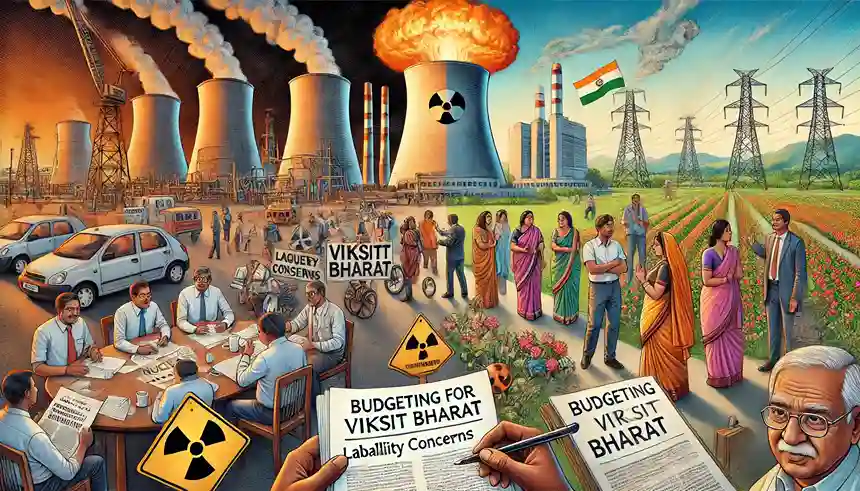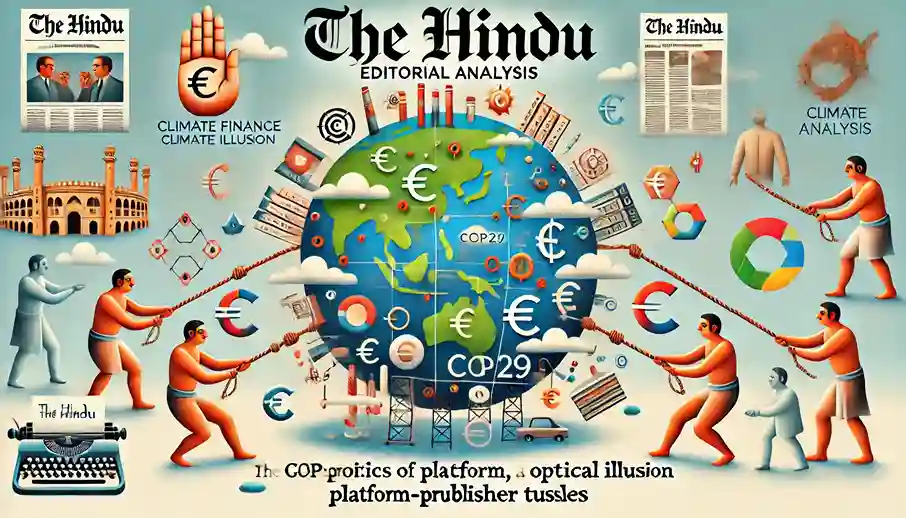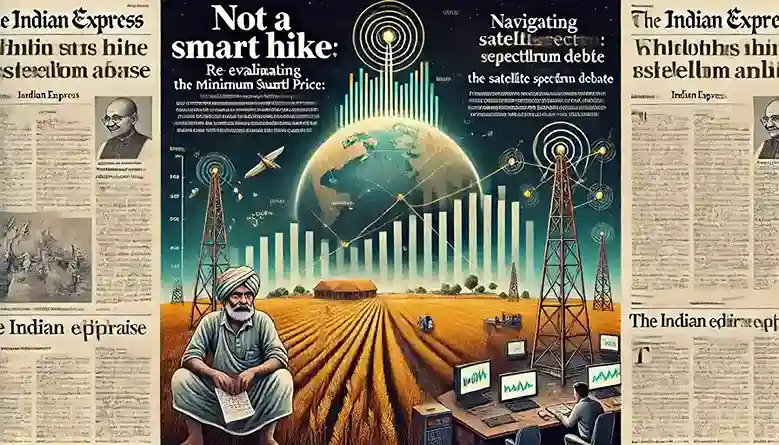Analysis of Indian Express Editorial 1: Not a Smart Hike
Context
Not a Smart Hike: Reevaluating the Minimum Support Price (MSP) Rise
Introduction
The recent announcement by the Indian government to raise the Minimum Support Price (MSP) for wheat to Rs 2,425 per quintal for the 2024-25 season has sparked discussions across various sectors. While the government offers justifications for this move, closer analysis reveals potential drawbacks that may outweigh the benefits. This article explores the broader implications of the MSP hike and argues for a more sustainable approach to enhancing agricultural productivity.
Understanding the MSP Hike: The Government’s Justifications
Depleted Stocks in Public Godowns
One of the key reasons cited for the MSP increase is the concern over wheat stocks in public godowns. As of October 1, 2023, wheat reserves stood at 23.78 million tonnes (mt), which is slightly above the required minimum of 20.52 mt. However, this justification appears weak given that rice stocks, including those derived from un-milled paddy, have reached a record high of 38.68 mt during the same period.
Both rice and wheat are distributed through the Public Distribution System (PDS), making it difficult to argue that depleted wheat stocks alone necessitate a significant MSP hike. The government’s move seems to reflect more of a precautionary stance rather than a well-reasoned economic necessity.
- Analysis of The Hindu Editorial – February 13, 2025

- Analysis of The Hindu Editorial – February 12, 2025

- Analysis of The Hindu Editorial – January 1, 2025

- Analysis of The Hindu Editorial – December 31, 2024

- Analysis of The Hindu Editorial – December 19, 2024

High Open Market Prices
Another rationale behind the MSP increase is the fact that wholesale wheat prices in Delhi have been hovering above Rs 2,800 per quintal. Under normal circumstances, such high prices should motivate farmers to increase wheat cultivation without needing an additional incentive in the form of a higher MSP. So, why push for this rise now?
The issue lies in understanding the delicate balance between market-driven incentives and government intervention. With prices already high, an MSP hike could distort market dynamics and lead to unintended consequences.
Drawbacks of the MSP Increase
Global Competitiveness
One of the most immediate concerns with raising the MSP is that it makes Indian wheat less competitive on the global market. For instance, Russian wheat is currently being exported at approximately $240 per tonne. After adding ocean freight and insurance charges, the total landed price at Indian ports would be around $280-285 per tonne, or roughly Rs 23,500-24,000 per tonne—still lower than India’s newly raised MSP.
This pricing discrepancy means Indian wheat will likely struggle to compete internationally, reducing export opportunities and adding further pressure on domestic markets.
Inflationary Pressures
A higher MSP also risks fueling inflation. With wholesale prices already elevated, any further increase in the MSP could contribute to rising food prices, which would hit consumers hard, especially those reliant on the PDS for basic staples. This is a classic example of well-intentioned policy leading to inflationary spirals in the broader economy.
Domestic Wheat Production and Stocking Limits
Government estimates indicate that wheat production hit a record 110.55 mt in 2022-23, with projections of 113.29 mt for 2023-24. Yet, despite these record numbers and measures like export bans and stocking limits imposed on traders since May 2022, wheat prices are still about 10% higher than they were a year ago. This suggests there are underlying issues in the supply chain that need to be addressed, rather than relying on MSP hikes to solve the problem.
In situations where stock shortages or overall availability become concerns, the government might instead consider allowing duty-free wheat imports, which could alleviate price pressures without distorting the domestic market.
The Structural Issue: Moving Beyond MSP
The obsession with increasing the MSP distracts from addressing the core issue: improving agricultural productivity. If the goal is to boost farmers’ incomes sustainably, attention must shift towards enhancing per-acre yields and reducing cultivation costs.
Low Yields and Regional Disparities
For example, while the MSP hike for pulses and oilseeds like chana, masur, and rapeseed-mustard (by Rs 210-300 per quintal) might encourage farmers to allocate more land to these crops, it won’t resolve the underlying issue of low yields. Mustard yields, in particular, remain dismally low across most of India, with the exception of regions like Punjab, Haryana, and western Uttar Pradesh, where wheat yields are comparatively higher.
Short-Term vs. Long-Term Thinking
Governments tend to favor short-term solutions like MSP hikes because they offer immediate political benefits. However, these measures do little to address the long-term challenges faced by the agricultural sector. There’s a clear need for more forward-thinking policies that prioritize investment in research and development to improve crop yields, water and nutrient-use efficiency, heat tolerance, and resistance to pests and diseases.
Way Forward: Investing in Sustainable Solutions
Rather than continuing to rely on MSP hikes as a quick fix, the government must focus on long-term investments that will drive sustainable growth in the agricultural sector. This includes:
| Key Areas for Investment | Potential Benefits |
|---|---|
| Breeding for Higher Yields | Increased crop productivity per acre |
| Water and Nutrient-Use Efficiency | Reduced input costs for farmers, leading to higher profits |
| Heat Tolerance and Pest Resistance | Greater resilience to climate change and environmental stresses |
| Research and Development in Agricultural Technology | Long-term improvement in both domestic food security and global competitiveness |
The ultimate goal should be to enhance India’s agricultural sector in a way that is both economically viable and environmentally sustainable, reducing the need for constant government intervention through mechanisms like MSP.
Conclusion
While the MSP hike may offer short-term relief to some farmers, it does not address the structural issues plaguing Indian agriculture. A more effective approach would involve targeted investments aimed at improving productivity, reducing costs, and making Indian produce competitive on the global stage. Without such reforms, the cycle of MSP hikes will continue, with diminishing returns and increasing economic distortions.
- [PDF] Kiran SSC 10600+ General Awareness Book English
![[PDF] Kiran SSC General Awareness Book English](https://savepdf.in/wp-content/uploads/2024/12/PDF-Kiran-SSC-10600-General-Awareness-Book-English-1156x650.webp)
- [PDF] – Manorama Yearbook 2025: A Comprehensive Guide to Knowledge and Exam Success

- [PDF] Blackbook 25000+ GA English Medium
![[PDF] Blackbook 25000+ GA English Medium](https://savepdf.in/wp-content/uploads/2024/11/PDF-Blackbook-25000-GA-English-Medium-1156x650.webp)
- [PDF] Reasoning Made Easy – Download Now
![[PDF] Reasoning Made Easy](https://savepdf.in/wp-content/uploads/2024/11/Reasoning-Made-Easy-1156x650.webp)
- [PDF] Police Recruitment Challenger – Download Now
![[PDF] Police Recruitment Challenger](https://savepdf.in/wp-content/uploads/2024/11/Police-Recruitment-Challenger-1156x650.webp)
Analysis of Indian Express Editorial 2: A High Stakes Game
Context
A High-Stakes Game: Navigating the Satellite Spectrum Debate
Introduction
India’s satellite communication sector is rapidly evolving, with major players like Reliance Jio, Airtel, and Starlink vying for a piece of the pie. But a critical issue has divided the industry: how should satellite spectrum be allocated? Should it be auctioned, or should it follow a more administrative process? As this debate heats up, the stakes for the future of satellite communications in India continue to rise. In this article, we’ll explore the arguments from both sides, delve into the legal and financial implications, and discuss the way forward for this high-stakes game.
The Spectrum Allocation Debate
The Divide Among Major Players
The satellite communication sector in India is witnessing a split between two schools of thought when it comes to spectrum allocation.
- Reliance Jio’s Stance: Reliance Jio has strongly advocated for the auctioning of spectrum, arguing that it promotes fairness and transparency. In a letter to both the Department of Telecommunications and the Telecom Regulatory Authority of India (TRAI), Jio emphasized that auctioning spectrum would ensure that only the most serious and capable players could enter the field.
- Starlink’s Argument: On the other hand, Elon Musk’s Starlink has pushed back against the idea of auctioning, citing the global precedent set by the International Telecommunications Union (ITU). According to Musk, satellite spectrum has traditionally been designated as shared and borderless, overseen by the ITU, and is not bound by national territorial limits. This, Starlink argues, makes administrative allocation a more appropriate model.
- Airtel’s Perspective: Airtel, led by Sunil Mittal, strikes a balance between the two views. While Mittal supports the idea of spectrum allocation, he believes that firms intending to serve retail customers should purchase spectrum and adhere to the same regulations as telecom operators. This ensures consistency across services provided to end-users.
- [PDF] “Arihant Computer Awareness Book 1” – Free Download
![[PDF] Arihant Computer Book.pdf” – Free Download for Competitive Exams](https://savepdf.in/wp-content/uploads/2025/04/PDF-Arihant-Computer-Book.pdf-–-Free-Download-for-Competitive-Exams-1040x650.webp)
- [PDF] The Pragmatic Programmer by David Thomas and Andrew Hunt

- [PDF] Structure and Interpretation of Computer Programs
![[PDF] Structure and Interpretation of Computer Programs](https://savepdf.in/wp-content/uploads/2024/12/PDF-Structure-and-Interpretation-of-Computer-Programs-1157x650.webp)
- [PDF] Computer Fundamentals by Anita Goel – Free Download
![[PDF] Computer Fundamentals by Anita Goel – Free Download](https://savepdf.in/wp-content/uploads/2024/11/Computer-FundameComputer-Fundamentals-by-Anita-GoelComputer-Fundamentals-by-Anita-Goelntals-by-Anita-Goel-1156x650.png)
- [PDF] – Mainframe Systems Programming: An Introduction – Download Now
![Mainframe Systems Programming: An Introduction – [PDF]](https://savepdf.in/wp-content/uploads/2024/10/PDF-–-Mainframe-Systems_20241004_162243_0000-1156x650.webp)
The Government’s Decision
Jyotiraditya Scindia, India’s Minister of Communications, recently brought clarity to the issue by confirming that satellite spectrum will be allocated through an administrative process, in line with international best practices. This decision aligns India’s approach with global standards, offering some finality to the ongoing debate.
Legal Provisions Governing Spectrum Allocation
The Role of Legislation
India’s legal framework for spectrum allocation plays a pivotal role in this debate. The government is empowered to assign spectrum administratively under certain conditions outlined in the First Schedule of the Indian Telegraph Act. This schedule includes 19 specific categories of services, such as satellite-based communications, for which administrative allocation is permitted.
TRAI’s Consultation Paper
In response to the ongoing discussions, TRAI released a consultation paper titled Terms and Conditions for the Assignment of Spectrum for Certain Satellite-based Commercial Communication Services. This paper examines the key issues surrounding spectrum allocation, providing insights into how the government may approach the matter moving forward.
Financial Models for Spectrum Charges
Several financial models are being considered to determine how spectrum charges should be applied. Two main options have emerged:
| Option | Description |
|---|---|
| Adjusted Gross Revenue (AGR)-Linked | Spectrum charges could be linked to a percentage of a company’s AGR, similar to how telecom operators are taxed. This model would scale with company revenues, ensuring that larger players pay more. |
| Upfront Fees | Alternatively, an upfront fee model could be implemented to ensure only serious and well-funded players enter the market. This would act as a financial barrier to entry, reducing the risk of overcrowding in the sector. |
High Stakes for the Satellite Communication Market
The future of satellite communications in India is bright, with Deloitte projecting that the country’s satellite broadband market could reach a value of $1.9 billion by 2030. This means the decisions made today will have long-term impacts on the growth of this industry. The competition is fierce, and the stakes are high—making it essential for policymakers to get the framework right from the start.
The Way Forward: Balancing Competition and Fairness
With the satellite communication market poised for explosive growth, the goal should be to create an environment that fosters healthy competition without stifling innovation or creating unnecessary barriers to entry. To achieve this, TRAI must provide clarity on key issues such as spectrum charges and other regulatory requirements in a timely and transparent manner.
Ensuring a Competitive Industry
The best outcome for the satellite communication sector is one where companies of all sizes can compete fairly while contributing to a vibrant industry. This requires a balance between encouraging innovation and ensuring that only serious players with the necessary financial backing and technical expertise can enter the market.
Conclusion
As India’s satellite communication sector stands on the brink of a massive transformation, the decisions surrounding spectrum allocation are more crucial than ever. With major industry players split on how spectrum should be assigned, and the government opting for administrative allocation, it’s clear that the path forward will have far-reaching implications. Ensuring a competitive, innovative, and financially viable industry requires careful planning, transparent regulations, and a focus on long-term growth. By striking the right balance, India can solidify its position as a global leader in satellite communications.

